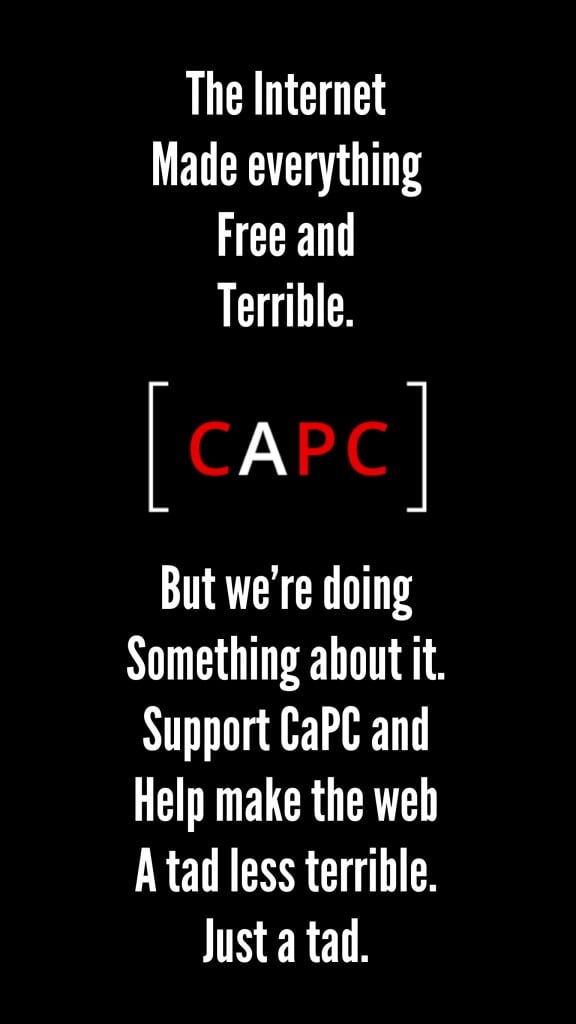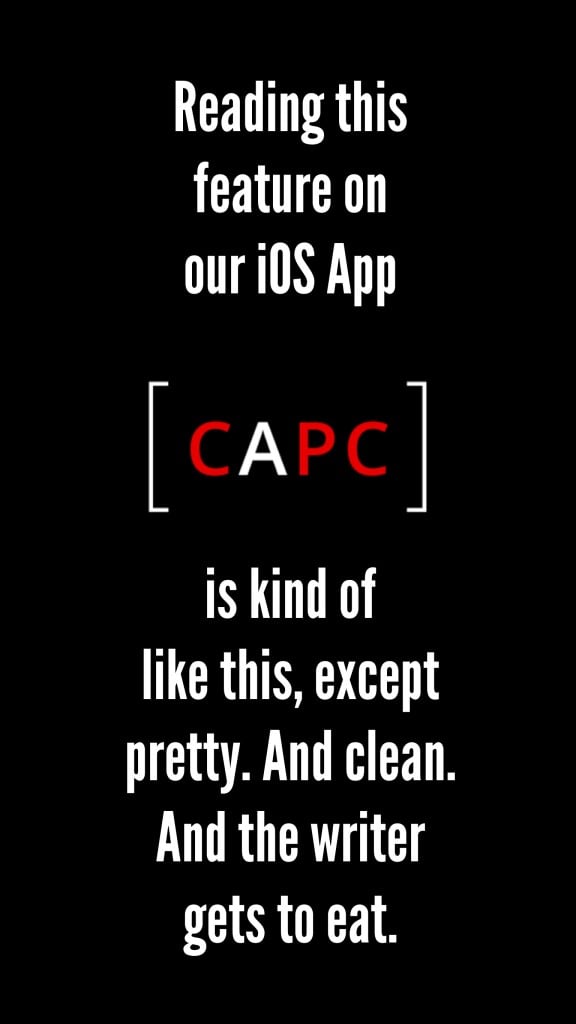The following is an exclusive feature that has been shared with you but is otherwise available only in Issue #7 of the Christ and Pop Culture Magazine. For more features like this, download our app for iPad and iPhone from Apple’s App Store.
After a one-week free trial, monthly and yearly subscriptions are available for $2.99 and $29.99 respectively. New issues are made available every other week. More information here.

It’s a rite of passage for parents in every age: putting up with That One Kid’s Show. You know the one. The one you can’t stand but your kid can’t get enough of. Back when I was a kid, it was Mr. Rogers. My little brother spent entire weeks of his summer vacation watching The Sandlot on VHS. And for many parents here in Japan, it’s a forty-year-old chestnut called Anpanman.
Anpan is a Japanese snack consisting of sweet bean paste stuffed inside baked soft bread. Anpanman is a flying piece of bread that wears Superman tights. Most of Anpanman’s forty-odd supporting characters also have food for heads, which is exactly the kind of thing you’d expect from the starvation-induced fever dreams of the WWII veteran that created it. For whatever reason, this show has dominated children’s entertainment in Japan for over twenty years, getting to the point where it can be more difficult to find a pre-school toy without his face on it than with.
Which makes it all the more surprising that this show is a blatant and deliberate Christian allegory. Japan is only about 1% Christian, but this tiny sliver of folks has produced many notable public figures, including the creator of this absurdly popular children’s franchise, Takashi Yanase. Yanase incorporates the allegory in several ways. Anpanman, the Christ figure, is the literal bread of life. He breaks off pieces of his head to feed people. He defeats his enemies, but always forgives them. He fights not for the destruction of his foes, but for their redemption, even when they never seem to come around. And, when he becomes weak, he is resurrected by Uncle Jam, a kind old baker who seems to know just about everything.
There are points at which the allegory breaks down. Anpanman is, after all, a children’s superhero who tells kids to play nice and eat their vegetables–at least, the ones that aren’t his friends. But, there are many who conclude that the Christ imagery is intentional. The parallels are strong enough that two separate Japanese people I know have, after reading parts of the Book of John, said “That’s just like Anpanman!”
I have mixed feelings about this. I’m glad that a fellow Christian has found success and that the people of this predominantly non-Christian nation can have some chance to be exposed to a Christ figure, if not the actual message of Christ. But, while the allegory is well fleshed out, it’s invisible if you don’t know the actual Gospel. And, then there’s the fact that Anpanman can be a really annoying show. Endless repetition, snail-slow pacing, relentless merchandising–every crime of the Blue’s Clues set can be found here in spades, making its attachment to the name of Jesus feel like more of a mixed victory, if not an embarrassment.
It’s not immediately clear whether Anpanman counts as a win or a loss for Christian media, and it’s not the only Christian work to share this kind of ambiguity. If anything, it often seems as though victories of artistic merit and popularity are won at the expense of Gospel clarity and orthodoxy. Conversely, works with real didactic value often end up dry and uninspiring, suffered by the faithful but ignored by the masses they are intended to reach.
Is this trade-off between entertainment value and evangelical value inevitable? What compromises are acceptable in creating effective evangelical art? Is evangelism through art even possible, or should Christians simply be content to create? Christian artists have offered a lot of different answers to these questions, and exploring those may give us some sense of the expectations and limitations inherent to the different approaches to incorporating the Christian message in creative expression. For the sake of discussion I have categorized Christian art according to how straightforwardly it presents its Christian content, starting with blatantly obvious Christian works that place their Jesus blazing on the rooftops, working downward to things that try sneak Jesus in the back door like a sixteen-year-old breaking curfew.
The Sermon
There are plenty of guys out there teaching peace and love, and if that’s all we’re here to do we can do it a lot better without the baggage that comes from linking these ideas to a two-thousand-year-old Jewish carpenter. No, Christian evangelism ultimately must incorporate uniquely Christian concepts like the deity of Christ, the cosmic reality of sin, and the power of atonement.
To that end, a good deal of Christian media focuses primarily on laying out the facts of Christianity. Material which used to be confined to church sermons and theology textbooks have, through Podcasts and popular literature, made solid forays into the realm of pop culture and entertainment, and their authors have sometimes found the kind of relevance and celebrity appeal normally reserved for more entertainment-oriented authors. Some, such as Rachel Held Evans with her Year of Biblical Womanhood, take this foray into pop territory far enough to breach even secular reading lists while still maintaining a definite focus on theological education and discourse. Looking to more evangelical audiences, celebrity pastors like Mark Driscoll and Rick Warren have managed to build substantial media empires without leaving the sermon format behind them, capitalizing on our culture of consumption even as they sincerely rail against it.
Rob Bell is a prime example of the success that can be had with this kind of up-front Christian message. Whether you consider him a herald of truth or a wolf in sheep’s clothing, his popularity and influence are undeniable, and he built it all on what are essentially sermons and self-help books. His book Love Wins single-handedly elevated the debate on universalism from the divinity school coffee shop to the New York Times best-seller list, and while his take on same-sex marriage hasn’t made quite that kind of splash, he’s still cemented his place in the conversation for years to come. Between him and other popular figures such as Mark Driscoll, Rachel Held Evans, Tim Keller, and Francis Chan, it’s not an exaggeration to say that the evangelical conversation is directed and defined by straightforward, sermon-esque Christian media.
Given its ability to convey lots of information and its abundant popularity, are there any problems with this approach? For one, it doesn’t generally reach people who aren’t interested to begin with. It’s defining the evangelical conversation, but it doesn’t seem to be doing a lot to bring more people into that conversation. These works are great for educating the faithful and driving debate among believers, but have not proven nearly as effective in sharing this message with those outside the fold.
And, as with any style, there are plenty of ways to do it badly. Some of the most popular figures are also among the most controversial, leading to the question of whether people are learning their theology from a leader they trust or elevating a leader who is willing to endorse their views. People vote with their money and the leaders get to speak the loudest, but it’s not apparent that people are voting for truth.
And, while the authors listed here have pretty polished productions, there are plenty more who don’t. Lest we forget the perils of evangelical literature done badly, Jack Chick’s name continues to be dragged through the internet in an undying parade of infamy. The secular aren’t generally eager to jump into the evangelical conversation, but they make quick exception when an easy target presents itself. In the end, a badly written theological work can do more damage than not writing anything at all.
The Hallmark Special
Moving down a step from these explicitly didactic works, we come to what I’ll call the “Hallmark Special:” entertainment media made with an evangelical message in mind. Named for the “inspirational” fare the Hallmark channel makes its bank on, these works may or may not include an overt Christian proclamation but leave no doubts as to their Christian target audience.
There is a lot of room to go wrong here. Plenty of people appreciate Hallmark movies, but many of them seem to do so as a safe haven from obscenity and violence–a non-threatening rice gruel for a stomach upset by Hollywood spice. And, those works that manage to muster higher acclaim and production values often do so at the expense of their Gospel clarity.
Consider semi-recent “inspirational” blockbusters like The Blindside. It was enjoyable enough and certainly not anti-Christian, but ultimately possessed more Christian flavor than substance. Imagine if the adoptive southern family had been replaced by kind upstate Jewish folk who just happened to have a major jones for football. The plot could have remained exactly the same, as could the heartwarming story of kindness and redemption, but the Christian undertones would have taken a major hit, showing that they may have been more inferred than actual. And that’s for a movie that was pretty decent. Think of how many Hallmark specials manage to be completely unwatchable while preaching a “Christianity” that goes no further than “be nice to people while living in the South.”
Or Fireproof. Hordes of Bible study groups filed into theaters to see it, and while many did so for their own edification, there was plenty of talk of bringing along so-and-so so that he could be exposed to a little Jesus and get his marriage back in order. But, judging by the reviews, those outside the fold weren’t buying it. Ed Gonzalez writes in L.A. Weekly, “Fireproof stops becoming relatable to us all and only to the easily, or already, indoctrinated.” A reviewer at the New York Times puts it more generously with (emphasis mine) “This is a decent attempt to combine faith and storytelling that will certainly register with its target audience.”
That’s not to say there’s no value in this sort of message. Not every evangelist needs to swing for the fences. Some people need to be shown that Christians are worth listening to before they’ll take the time to sit in on more serious conversations, and helping them have fun while Jesus is around can be one way to do that. And, there’s nothing wrong with wanting to watch a movie without being bombarded by sex, violence, and city folk.
What we do need to be careful of, though, is being honest about what we’re doing. If we try to cram an altar call into what is otherwise a straightforward drama, we can easily end up with a tortured plot that neither evangelizes nor entertains. It’s not impossible to make art that both expounds Christian teaching and makes non-Christians interested enough to hear it. I remember several good conversations I had when Mel Gibson’s The Passion of the Christ was still in theaters. But, it’s a much higher bar than simply making something inoffensive.
And, if we try to make movies about “Christian values,” we need to remember that aside from a few sexual norms, most people already share our values. They don’t need to be told how to be good–that’s already written on their hearts. They need to be told how to be saved. Anything we say about right living apart from Jesus, no matter how well spoken, can easily be co-opted by any of a multitude of other value systems. This can still be of value to people looking for a break from Hollywood’s excess, but we need to be realistic about the limited teaching and reaching potential inherent in the format. Operators in this genre need to be deliberately, painfully clear with themselves on whether they’re willing and capable of putting in the extra talent and effort necessary to make something that can successfully broaden the evangelical conversation or simply catering to the easily offended.
The U2
 This category is not so much Christian art, but art by Christians. These artists aren’t trying to hide their faith, but they’re content to let other themes take the forefront as they try first and foremost to express themselves and make something that satisfies them aesthetically as well as spiritually. Music is particularly rife with this sort of creative mind. While explicitly Christian music is prone to the same problems as inspirational movies and evangelistic novels, Christians who simply set out to create good music often find themselves succeeding. Devout believers can be found at the top of every genre, and plenty of them manage to let their faith find its way into their lyrics and themes, even if they don’t dominate their work. Moreover, unlike the more explicit and deliberate types of spiritual expression, creations in this middle to low range of godly focus seem more likely to benefit aesthetically and commercially from spirituality rather than be burdened by it.
This category is not so much Christian art, but art by Christians. These artists aren’t trying to hide their faith, but they’re content to let other themes take the forefront as they try first and foremost to express themselves and make something that satisfies them aesthetically as well as spiritually. Music is particularly rife with this sort of creative mind. While explicitly Christian music is prone to the same problems as inspirational movies and evangelistic novels, Christians who simply set out to create good music often find themselves succeeding. Devout believers can be found at the top of every genre, and plenty of them manage to let their faith find its way into their lyrics and themes, even if they don’t dominate their work. Moreover, unlike the more explicit and deliberate types of spiritual expression, creations in this middle to low range of godly focus seem more likely to benefit aesthetically and commercially from spirituality rather than be burdened by it.
It’s no accident that music would be the locus of this kind of expression. There are several things about the medium that make it the ideal breeding ground for the expressive, non-evangelistic Christian artist. Music is at once intensely personal and immensely vague. Deep, personal feelings of spirituality can be harnessed to create an intense experience for the listener even if this listener remains oblivious to the details of that experience. Also, commercially viable music can be created by a small group of people, or, in some cases, one particularly industrious person working alone, avoiding much of the “watering down” that comes from the committee process necessary for larger productions like movies and television shows.
It’s very fertile artistic ground, and it’s the range of spiritual expression that most consistently produces the best art. But, these qualities bring some disadvantages as well. In some genres, understanding the simple meaning of the words is something of an accomplishment, which can be superfluous or even detrimental to appreciation (“What do you mean, with the terrorists?!”). Many of us were thrilled when U2 “came out” as a Christian group, but there’s a reason they had to “come out–” the messages of their songs weren’t able to communicate the full extent of their religion without some outside help. That’s the challenge inherent in music, or any other Christian art that utilizes Christianity as a secondary inspiration–the more specific the message, the less likely the audience can translate it into a personal feeling. Preference is given to simple pop vagaries while nuanced theological expression comes with a severe handicap. And as always, it’s still perfectly possible to screw up everything at once.
The Committee
Our country has its Amish villages, cloistered monastics, and Focus on the Family quarantined households, but most of the Christians in America choose to integrate themselves into society to some degree. Many Christians find themselves contributing artistically in projects that are directed or dominated by secular or even anti-theistic sentiments. It’s just a fact of business that if you want to produce the biggest, most widely consumed media our society has to offer, you have to work with a big group, and more often than not that means working with teams chosen for talent rather than faith.
While this interaction doesn’t normally convert an atheist production into a Christian one, it does sometimes result in some of the most nuanced and widely consumed faith dialog in mainstream media. Matt Groening’s The Simpsons is a great example of an inter-faith writing team that occasionally gave voice to some surprisingly genuine and well-executed Christian expression. Ned Flanders, while portrayed with the show’s characteristic cynicism, is often made out as a too-good-for-this-world foil to the town’s assortment of deadbeats. He is allowed genuinely sympathetic development when his wife dies and again when his business is demolished, and his renewed faith after struggling with despair constitutes the resolution to those particular episodes. Recently these moments have become further and further apart as the writers see fit to use him as a punching bag for the more objectionable foibles of the religious right, but on occasion a little light still breaks through the clouds into one of the biggest stages available.
In addition to positive Christian examples, there’s also the negative ones that get aborted during the creative process. Consider the recent Bioshock kerfuffle. Details of what exactly was changed are still sketchy, but what we do know is that input from a Christian on the project led to the alteration of a story element which this individual originally found offensive to the Christian message. How many times does this happen silently, without a news story, just because some normal Christian was present at the right time to steer the project in a better direction?
Perhaps this is what happened with producer and professing Christian Ralph Winter. In addition to producing Christian movies like Left Behind and Thr3e, Winter has been at the helm of blockbusters like X-Men and Star Trek. Both of these movies were popular, well-received, and, most interestingly, took old franchises with strong anti-Christian elements and remade them into something less confrontational to the Christian faith. In the case of Star Trek this may have been incidental, since while it did and still does, to some extent, act as a secularist rallying banner, its forays into religion-bashing were not the cornerstone of the story. However, the transformation of X-Men is certainly more dramatic. While some Christians may not appreciate the movie’s pro-homosexuality themes, the original was even less charitable to Christianity, casting a preacher as the main villain and using religious fundamentalism as a synonym for hate and bigotry. In Winter’s adaptation this character becomes a politician, neutralizing much of the condemnation of the church inherent in the original. Whether this shift occurred in deference to anyone’s beliefs or simply to make the film more marketable, having a prominent Christian at the helm certainly couldn’t have hurt.
So, with these kinds of results, are there are any downsides to taking the plunge and swimming with the sharks? For one, Christians don’t always have the chance to take the reins. Those lower on the ladder may be forced to make the choice to go along or get out. And, while some Christians have managed to change entertainment, it’s much easier to find examples of entertainment changing Christians. Consider this list of prominent Hollywood Christians. While there are some big names present like Jane Fonda and Martin Sheen, these and others contest key elements of faith, like the divinity of Jesus. Still others, like Chris Tucker, profess faith at one point but then live in ways that make this faith, and its influence on their art, invisible.
There’s clearly a lot to be gained by being unafraid to get your hands dirty and work in environments that aren’t sterilized and Christian. But, there are some dangers as well. Overall, the balance probably lies in favor of getting involved over staying out, but Christian artists should not operate under the illusion that they will be able to sanctify everything they get involved with. As with any unequally yoked relationship, there’s perhaps a better chance of being changed by one’s environment than successfully converting it to some Christian ideal.
With all of this considered, what constitutes the most effective level of Christian expression? In the end, there’s room for all levels of Christian art, and Christian expression wouldn’t be as full without any of them. The problems exhibited by the failures come not from trying to include too much or too little Jesus. They come from having unrealistic expectations, or from being just plain bad. If boundaries are respected and quality enforced, good Christian art can be found at any level of spirituality. Even the “inspirational” category that I raked through the coals so thoroughly is capable of true brilliance–remember that classic works like The Chronicles of Narnia fit squarely within this niche of thoroughly Christian entertainment.
Failure comes first when we try to force an amount of Gospel into a story that can’t handle it. Love is easy enough, and redemption and even resurrection are ready accessories to good drama, but a sinner’s prayer conversion followed by a life change that can be summed up in ninety minutes of orchestrally scored staring at ceiling lights generally goes beyond what most people can accept as a natural, engaging story. Conversely, a sermon or theology textbook has the freedom to delve into the details, but it shouldn’t count on presenting those details to someone who hasn’t already gone out of their way to hear them.
 More importantly, however, failure comes when we make bad art. Creating for Jesus is no excuse to create something that is awful. At best we end up torturing a captive audience without entertaining or educating. At worse we actively drive people away from God by perpetuating the myth that his Gospel is the enemy of creativity and expression.
More importantly, however, failure comes when we make bad art. Creating for Jesus is no excuse to create something that is awful. At best we end up torturing a captive audience without entertaining or educating. At worse we actively drive people away from God by perpetuating the myth that his Gospel is the enemy of creativity and expression.
With that in mind, does Anpanman constitute a success or a failure? He does not present the Gospel clearly. He is a shameless marketing shill, and the indirect torturer of at least two generations of parents. But, he is also a beloved character, created by a Christian as a genuine expression of faith, who just happens to make his owners an obscene pile of money. Anpanman would be pretty pathetic if he were our only image of Jesus, but as one Jesus among many, he’s certainly got a place.
Nicholas Tieman is a freelance programmer and pre-school teacher soon returning to America from Okayama, Japan. Together with his wife Ashley, he enjoys good cartoons, bad movies, and mixing politics with religion.
Illustration courtesy of Seth T. Hahne. Check out Seth’s graphic novel and comic review site, Good Ok Bad.


